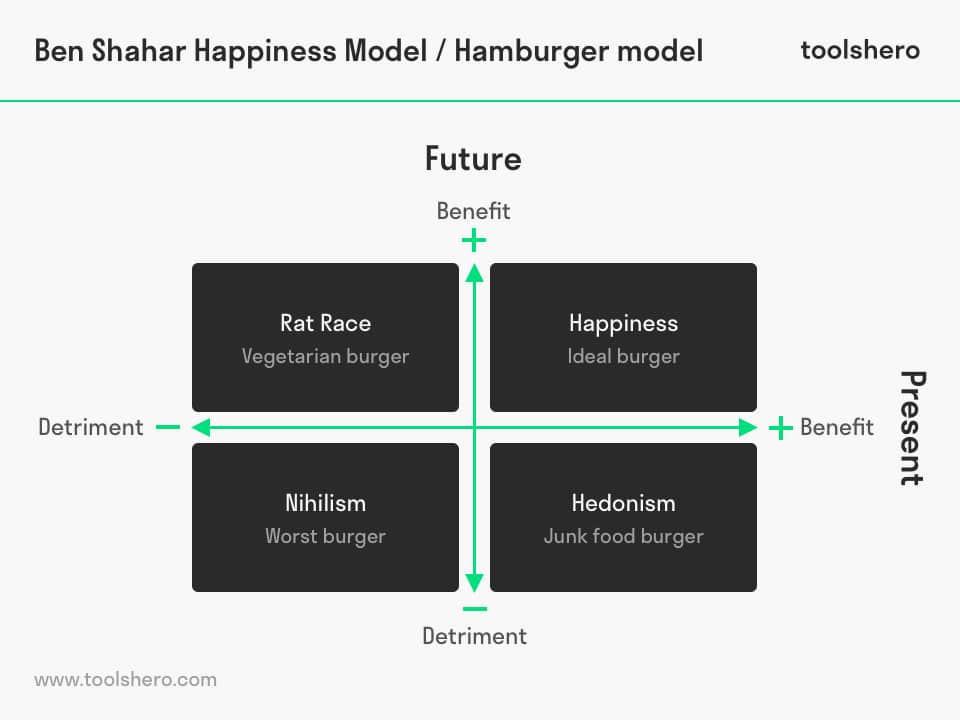Tal Ben-Shahar’s Happiness Model

Tal Ben-Shahar’s happiness model: this article explains Tal Ben-Shahar’s happiness model or hamburger model, in a practical way. After reading, you’ll understand the basics of this powerful psychology tool.
What is Tal Ben-Shahar’s Happiness Model?
The happiness model, also known as the hamburger model, is a model developed by Tal Ben-Shahar. Tal Ben-Shahar is a professor at Harvard University, and rose to fame thanks to his lessons on personal happiness. According to him, humans do not need everything they believe they need. Happiness is first and foremost about enjoying what you have now. Contentment and being fulfilled in what someone does determines if someone is happy.
Tal Ben-Shahar himself defines happiness as the overal feeling of pleasure and meaning. A happy person can enjoy positive emotions, if he or she experiences life as something meaningful. Tal Ben Shahar explains in his theories how you can live a life filled with enthusiasm and joy.
The Harvard professor went on to write the book ‘Happier’. In this book, he christened his previously developed model as the hamburger model. A visualisation of this very simple model can be seen below.
How did the Happiness Model come about?
Tal Ben-Shahar explains in one of his books how he came up with the model of Happiness. Shahar likes squash, and prepared for an upcoming tournament over the course of a few months. He kept to a strict diet, and worked out a lot.
Occasionally, he would allow himself some junkfood. In the last four weeks before the tournament, however, he only ate chicken, fish, vegetables, fruit, and clean carbohydrates. As a reward, he told himself, he was allowed to eat junkfood for two days after the tournament.
The moment the tournament was over he headed to his favourite hamburger joint. He ordered four hamburgers and sat down with his grand prize. Once he unwrapped the burger and reached for his mouth, he stopped. For months, he had looked forward to this, and now he didn’t want the burger anymore.
He started to think about why, and came to the happiness model, and later on the hamburger model. Each archetype within the model describes a clear pattern of attitudes and behaviour. Everyone is one of these four archetypes.
Positive psychology
Along with his book Happier, Tal Ben-Shahar also wrote the book The Pursuit of Perfect: How to Stop Chasing Perfection and Start Living A Richer, Happier Life. In this book, he describes the same as what he passed on to his Harvard University students during his remarkably successful lessons.
Tal Ben-Shahar’s philosophy is: if you can learn how to live for both today and tomorrow, you will learn to balance your personal needs with long term goals, and you can enjoy life in a way you have not done before. His ideas come from positive psychology. Positive psychology is the scientific study of optimal human functioning. The concept was first introduced by Dr. Marin Seligman in 1998. He was the president of the American Psychological Association at the time. Seligman was also the director of the centre for positive psychology at the University of Pennsylvania.
Psychology mainly focuses on things that keep the human mind busy, such as depression, anxiety, neurosis, obsessions, paranoia, and other behaviours. Seligman and his colleagues asked a different research questions: what are the conditions that allow people to flourish?
The base idea is that the pursuit of happiness is something you can learn. Just as someone can learn a foreign language, someone can also learn to be happier.
The 4 archetypes of the Happiness Model
Tal Ben-Shahar explains in his book that there are about four types of people. Each deal with pain and pleasure differently. The four archetypes are explained below.
Hedonism
A hedonist is someone who tries to maximalise pleasure and minimise pain as much as possible. The analogy for this archetype is the tasty junkfood burger. Eating a junkfood burger would provide a current benefit: enjoyment. But also damage, as there can be consequences later on. This explains the archetype of hedonism in a nutshell. Hedonists are often referred to as epicureans. Epicureans live according to the hedonistic principle: seek pleasure, and avoid pain. They focus on the present and ignore all possible negative consequences of their behaviours and actions in the now.
Tal Ben-Shahar explains about this archetype: this is the hell the hedonist confuses with heaven. Without a long term goal, or without a challenge, life no longer feels meaningful. A human cannot find happiness if only pleasure is being sought and pain is being avoided. Compare it to eating a delicious meal. If you ate this meal every day, how long would it take you to get completely sick of it?
Rat racing
The second type in the Happiness Model is introduced via an analogy of a rat racer. This analogy is that of a vegetarian hamburger that is only made of the healthiest ingredients. The problem is that this burger doesn’t taste good. Eating this burger now would not provide any benefit in the present: the burger tastes bad. In the future however, it will provide benefits in the sense that someone will reap the benefits of eating healthy for a long time. These people are the exact opposites of hedonists. The rat racer’s motto is: work now, play later. He suffers now, to gain more in the future.
Tal Ben-Shahar also provides his perspective on this archetype in his book. He explains that there are so many rat racers around the world because various cultures enhance this belief. How many kids work on school every day to get a special present from mum or dad at the end of the semester for good grades?
This way, a human is not rewarded for the journey itself, only the completion thereof. Societies are tough, and only reward results, not processes. When someone has finally reached a destination, we confuse relief with happiness. The heavier the burden feels during the trip, the stronger and more pleasant the relief is at the end of the journey.
If someone experiences a lot of these moments, where relief is confused with happiness, it will only enhance the illusion that reaching goals will make us happy. While the sensation of relief can definitely resemble happiness, it is real and nice after all, it should not be seen as happiness.
Nihilism
The third archetype of the Happiness Model, is represented by the nihilist. Nihilism in philosophy is a term that is used to deny the existence of value or meaning in our world. The term is strongly linked to philosopher Friedrich Nietzsche’s work. He was focused on nihilism.
The analogy for this archetype is a burger that tastes bad and is unhealthy to boot. By eating this burger, damage is experienced in the present due to the fact that the burger does not taste good, and future damage occurs due to the poor quality of the ingredients. This archetype describes someone who has lost their lust for life.
This is someone who does not enjoy the present, nor does this person have a future goal. The epicurean is known for the false conviction that happiness can be achieved through short-lived pleasure, without a future goal. The rat racer has the false conviction that reaching a specific destination will provide happiness.
The nihilist, however, holds on to the false conviction that no matter what you do, happiness cannot be experienced.
Happiness
Eating the last burger, according to the comparison, will have benefits for both the present and the future, in the sense that it tastes good and because the person eating it feels good in the long term with his healthy lifestyle. This approach offers the most benefits out of all, but is only chosen by few people.
The most commonly made mistake is that people think in black and white: it’s either one or the other. This mentality leads to viewing things incorrectly. The truth rarely lies in extremes. Virtually all the time, truth is a synthesis of various components.
It is not either one or the other, it is one and the other too. In the case of the last archetype, the synthesis comes from combining elements from both the rat racer and the hedonist. By adopting this style, present activities provide pleasure, while they lay the foundation for a fulfilling and meaningful future.
How can I become happy?
Tal Ben-Shahar shares some theories, methods, and tips linked to positive psychology for living a happy life. A few are explained below. Some of these methods are supported by science, others are not.
Relationships (face-to-face)
Having interpersonal relationships with others provides pleasure to humans, and leads to happiness. A condition for this is that these relationships are not maintained via a screen. If we spend time with our loved ones, we are investing time in ourselves, our well-being, and our loved ones’ well-being.
Simplifying
Simplifying life is another important tip from Tal Ben-Shahar. Sometimes people focus too much on being in a hurry. Having too many things to do, so we are done earlier, or concentrating on what is going wrong in order to solve it. These are all things many people do. It is easy to lose yourself in all of this.
Simplifying makes life easier. Someone realises the issues are still present, but lacks the tools to solve them. Know that things will not always go well, but there will always be something that goes well. Concentrate, focus, and enjoy what you do.
Physical exercise
Stress is a natural response that we should be happy about, but unfounded tension is something else. Tension can wreak havoc on a person, but it can be lessened through physical exercise. Enough exercise makes the brain produce endorphins. Endorphins naturally enhance feelings of wellness and happiness.
Gratitude
According to Tal Ben Shahar and the hamburger model, being grateful provides feelings of happiness. If a person is conscious of all the things he or she has, and does not experience it as self-evident to have these things, that person is already that much closer to sustainable pleasure and well-being.
Freedom in being
Everyone gets heated every once in a while. Everyone also has feelings and we all respond to what happens around us. People must be free to express themselves without fear of what others may think or feel about that. Emotional intelligence is the key to getting to know yourself, and to build healthy relationships with others.
Free time
Tal Ben-Shahar’s final tip is to spend time on hobbies or other things we truly enjoy. Because people have various responsibilities in life, it is especially important for people to make free time for things they really love.
Now it is your turn
What do you think? Are you familiar with the explanation of Ben-Shahar’s happiness model? Are you already familiar with this model for personal happiness? Are you going to use this model or recommend it to someone else? Which archetype represents your way of life? Do you think you can develop from one certain type to a different type? And what could trigger this? Which archetype will help people develop the most? Do you have any tips or comments?
Share your experience and knowledge in the comments box below.
More information
- Ben-Shahar, T. (2007). Happier: Learn the secrets to daily joy and lasting fulfillment. McGraw-Hill Companies.
- Ben-Shahar, T., Conger, E., & Original material© 2009 Tal Ben-Shahar. (2009). The pursuit of perfect. HighBridge Company.
- Russo-Netzer, P., & Ben-Shahar, T. (2011). ‘Learning from success’: A close look at a popular positive psychology course. The Journal of Positive Psychology, 6(6), 468-476.
How to cite this article:
Janse, B. (2020). Tal Ben-Shahar’s Happiness Model. Retrieved [insert date] from Toolshero: https://www.toolshero.com/psychology/happiness-model/
Published on: 04/11/2020 | Last update: 08/21/2023
Add a link to this page on your website:
<a href=”https://www.toolshero.com/psychology/happiness-model/”>toolshero: Tal Ben-Shahar’s Happiness Model</a>













